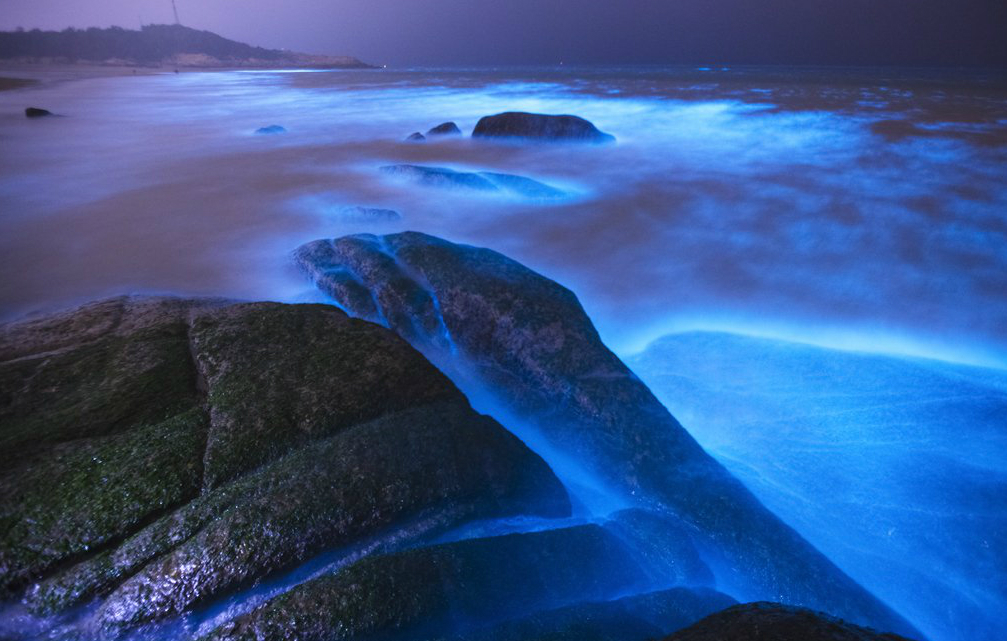China’s Otherworldly Blue Tears

Have frequent flier miles burning a hole in your pocket and need new ideas for where to go? Check out our weekly Have Miles Will Travel column to discover strange, wonderful and unique destinations around the world.
On this week’s edition of Have Miles Will Travel, we’re going to explore one of the most beautiful and ethereal natural phenomena on earth. Far from the bustle of Taipei is the little-known attraction of China’s blue tears. They are fairly far off of the beaten path, but this bioluminescent wonder of the world gets brighter and more beautiful every year. And, if you have miles to spare, they’re well worth the trip.
What Are They?
China’s Blue Tears are, surprisingly, caused by the tiny red single-celled organism Noctiluca scintillans. At night, when the water is warm, they emit a bioluminescent blue glow when they are disturbed and sparkle and shimmer across the surface of the water to create a breathtaking spectacle.
Where Are They?
You’ll find sea sparkles (as they’re commonly known) all along the Chinese coast of the East China Sea, but they are especially spectacular when viewed along the coast of Taiwan’s Matsu Islands.
Nangan and Beigan are the Matsu Islands where most tourists head to see the bioluminescent sea sparkles. But, they can also be spotted on some of Matsu’s smaller, less-crowded islands if you want to feel like you’re alone on a glowing alien landscape or post something on Instagram that makes you look like you are.
How to Get There?
You can fly into Beigan (MFK) or Nangan (LZN) airport via UNI Air from Taipei, Taiwan. The flight takes about an hour and the planes are small, so be sure to book this flight in advance. Once you’re on the island, scooters are the most popular mode of transportation and can be rented for around NT$500 (or USD$15 per day). Hotels on the larger islands can often tell you how to rent one or even give you a discount.
You can rent a car for NT$2,000 (or USD$65 per day) or hire a driver for several hours for almost half that price. If you’re looking to head out to one of the smaller islands, you can take a short ferry ride, about NT$100 (or USD$4), to most of them.
When to See Them?
Summer nights are the best time to see China’s Blue Tears. The waves of the East China Sea at this time of year are perfect for exciting and illuminating the blue sparkles.
How Did They Get the Name?
Why is something so beautiful named something as sad as “China’s Blue Tears?” It may have something to do with the nature of the red organisms that illuminate the water. Scientists think that they feed on pollutants in the water. And, as the region produces more pollutants, the Blue Tears grow in number and in beauty.
What Else Can You Do?
There’s plenty to do on the Matsu Islands. There’s the Iron Fort, Chiang Kai-Shek’s Wall, and the fascinating traditional architecture of Fujian: beautiful stone houses that you can spend the night in while you’re on the island.
This region is also famous for its fresh seafood. Be sure to try fish noodles in Jieshou Village on Nangan which has many restaurants that feature traditional dishes you may not find in bigger cities like Taiwan. After you eat, head to the Matsu Distillery to see how they make the famously high octane Taiwanese Kaoliang liquor. You may even be able to try a sample, and it’s best to do that on a full stomach.























@AsiaTraveler - not according to every currency conversion site out there.... https://transferwise.com/us/currency-converter/twd-to-usd-rate?amount=500 https://themoneyconverter.com/TWD/USD https://currencyconvert.online/twd/usd/500 https://www.xe.com/currencyconverter/convert/?Amount=1&From=TWD&To=USD
The currency conversions in this article are way off. 1 NT equals about 30 cents USD, so 500 NT would equal about USD $165.